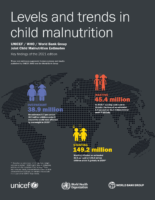UNICEF-WHO-The World Bank: Joint child malnutrition estimates — levels and trends – 2021 edition
The UNICEF, WHO and the World Bank inter-agency team update the joint global and regional estimates of malnutrition among children under 5 years annually.

The UNICEF, WHO and the World Bank inter-agency team update the joint global and regional estimates of malnutrition among children under 5 years of age each year. These estimates of prevalence and numbers affected for child stunting, overweight, wasting and severe wasting are derived for the global population as well as by regional groupings of United Nations (UN) regions and sub-regions, Sustainable Development Goals (SDG), UNICEF, WHO and World Bank regions, as well as World Bank country-income group classifications.
A new country-level model was used to generate the country, regional and global estimates for stunting and overweight, for the 2021 edition and annual estimates from 2000 to 2020 are newly available. For wasting and severe wasting, estimates are only presented for the most recent year (2020), as in previous editions; work is underway to improve estimation methods for wasting. The key findings report for the 2021 edition of the JME presents country data, a country’s share of the global burden, and progress assessment towards 2030 targets for the first time. These estimates do not account for the impact of COVID-19, but the pandemic is expected to exacerbate all forms of malnutrition due to worsening household income especially in the vulnerable population, constraints in the availability and affordability of nutritious food, disruptions in essential nutrition services, and reduced physical activity.
